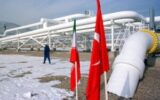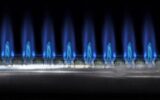
While Recep Tayyip Erdogan traveled to Ashgabat to participate in celebrations of the 30th anniversary of Turkmenistan's neutrality, US and EU sanctions have cast a heavy shadow over Turkey's efforts to increase gas imports from Iran and launch a swap agreement with Turkmenistan; an agreement that was abruptly halted after several successful months, leaving Turkey's future winter energy supply uncertain.

South Pars announced that it will meet the majority of its operational needs by relying on domestic capacity and cooperation with knowledge-based companies; a path that has brought the complex to the threshold of industrial independence by localizing more than 15,000 components and creating a smart supply chain.

Gas consumption in the domestic, commercial, and small industrial sectors increased as temperatures dropped in the second week of December, reaching a peak of 530 million cubic meters on December 12, bringing total weekly consumption to more than 3.65 billion cubic meters.

The Integrated Planning Manager of the National Iranian Gas Company announced: "With timely major repairs, complete coordination of operational departments, and implementation of smart projects, the gas network has been fully prepared for the cold season."

A spokesman for the Tehran Provincial Gas Company announced the gas cutoff for the railway company and the issuance of a warning to the Ministry of Roads and Urban Development on the first day of implementing the special patrols plan for gas consumption management.

The National Iranian Gas Company and the School Renovation Organization signed a memorandum of understanding to replace high-efficiency heating systems and improve engine rooms; the main goal of this cooperation is to reduce energy consumption and optimally manage gas resources in the country's schools.

Saeed Tavakoli announced at the signing ceremony of the National Gas and Education Memorandum of Understanding: 850 million cubic meters of gas will be injected into the network daily; the country's schools will become a model for optimizing energy consumption with high-efficiency and smart power plants.

The Director of Energy Consumption Optimization at the National Petrochemical Company announced that the petrochemical industry has succeeded in saving 1.7 billion cubic meters of natural gas in the past four years by implementing optimization projects, and said: "Achieving annual savings of more than 200 million cubic meters has also been targeted for this year."

During the cold months of the year, 120 million cubic meters of gas are burned in Tehran daily, which results in the production of 270,000 tons of smoke and the destruction of 400,000 tons of oxygen in the air. Incomplete combustion of gas has led to the release of toxic and deadly CO gas and various diseases and silent deaths.

On the eve of winter and increased gas restrictions, the electricity industry has announced that only 14 power plants in the country are allowed to use diesel fuel, and this year, low-sulfur fuel has been made available to boiler units; a move aimed at reducing environmental concerns and ensuring a stable supply of electricity during the cold days of the year.










